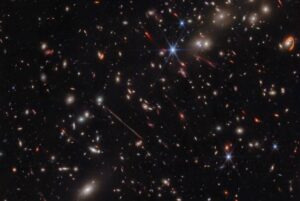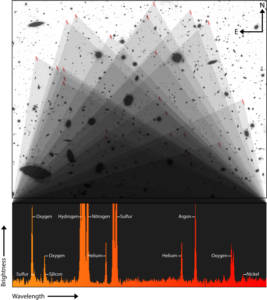JWST unexpectedly reveals nickel and oxygen, which are typically difficult to observe

A Webb telescope image of a galaxy cluster known as “El Gordo,” which is an example of a “cosmic teenager.” Credit: NASA, ESA, CSA
Similar to human teenagers, teenage galaxies are awkward, experience growth spurts and enjoy heavy metal — nickel, that is.
A Northwestern University-led team of astrophysicists has analyzed the first results from the CECILIA (Chemical Evolution Constrained using Ionized Lines in Interstellar Aurorae) Survey, a program that uses NASA’s James Webb Space Telescope (JWST) to study the chemistry of distant galaxies.
According to the early results, so-called “teenage galaxies” — which formed two-to-three billion years after the Big Bang — are unusually hot and contain unexpected elements, like nickel, which are notoriously difficult to observe.
The research was published on November 20, 2023 in The Astrophysical Journal Letters. It marks the first in a series of forthcoming studies from the CECILIA Survey.

Light from 23 distant galaxies, identified with red rectangles in the Hubble Space Telescope image at the top, were combined to capture incredibly faint emission from eight different elements, which are labelled in the JWST spectrum at the bottom. Although scientists regularly find these elements on Earth, astronomers rarely, if ever, observe many of them in distant galaxies. Credit: Aaron M. Geller, Northwestern, CIERA + IT-RCDS
“We’re trying to understand how galaxies grew and changed over the 14 billion years of cosmic history,” said Northwestern’s Allison Strom, who led the study. “Using the JWST, our program targets teenage galaxies when they were going through a messy time of growth spurts and change. Teenagers often have experiences that determine their trajectories into adulthood. For galaxies, it’s the same.”
One of the principal investigators of the CECILIA Survey, Strom is an assistant professor of physics and astronomy at Northwestern’s Weinberg College of Arts and Sciences and a member of Northwestern’s Center for Interdisciplinary Exploration and Research in Astrophysics (CIERA). Gwen Rudie, a staff scientist at Carnegie Observatories, co-leads the CECILIA Survey with Strom.
Named after Cecilia Payne-Gaposchkin, one of the first women to earn a Ph.D. in astronomy, the CECILIA Survey observes spectra (or the amount of light across different wavelengths) from distant galaxies.
“Naming our JWST survey after Cecilia Payne-Gaposchkin was intended to pay homage to her pioneering studies of the chemical makeup of stars,” Rudie said. “Allison and I recognize that our own work revealing the chemistry of these very early galaxies is built upon her legacy.”
Strom likens a galaxy’s spectra to its “chemical DNA.” By examining this DNA during a galaxy’s “teenage” years, researchers can better understand how it grew and how it will evolve into a more mature galaxy.
For example, astrophysicists still don’t understand why some galaxies appear “red and dead” while others, like our Milky Way, are still forming stars. A galaxy’s spectrum can reveal its key elements, such as oxygen and sulfur, which provide a window into what a galaxy was previously doing and what it might do in the future.
“These teenage years are really important because that’s when the most growth happens,” Strom said. “By studying this, we can begin exploring the physics that caused the Milky Way to look like the Milky Way — and why it might look different from its neighboring galaxies.”
Continue to the full Northwestern news article.

